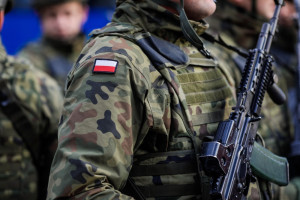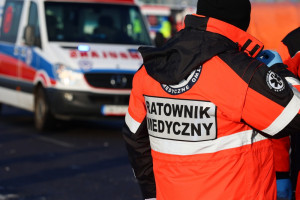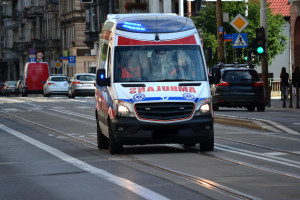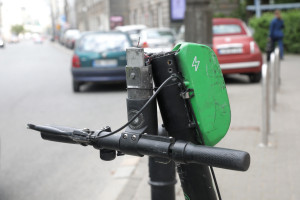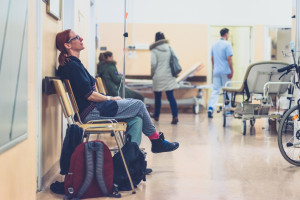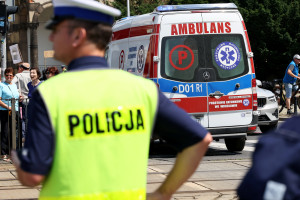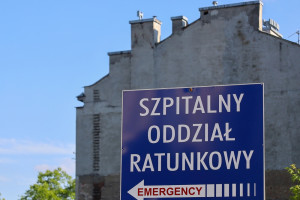They can use pepper spray. We know the details of the negotiations to improve medic safety.

- The Ministerial Team for Medical Personnel Safety has made arrangements for solutions to improve the safety of medics, including members of emergency medical teams.
- The Ministry of Health does not recommend the mandatory introduction of pepper spray as a means of personal defense in emergency medical services, but medics can buy it privately and use it as part of self-defense.
- There is no consent for an "overlay" on the system that would allow paramedics to be warned that they are going to a dangerous address. According to the Ministry of Health, this would stigmatize patients.
- There will be no ongoing analysis of cases of attacks on medics in order to draw conclusions regarding safety procedures
- - This, as one might assume, results from the fear of pointing the finger of blame - says Tomasz Socha, negotiator and representative of the National Council of Paramedics during meetings of the ministerial team
- From January 1, 2026, rescuers are required to wear knife-resistant vests, but this is controversial.
Following the shocking murders of a paramedic in Siedlce and a doctor in Krakow by patients, the medical community demanded that the Ministry of Health take action to improve the safety of paramedics. These decisions were reached during meetings of the Medical Personnel Safety Team. We discussed the details of these decisions with Tomasz Socha, who negotiates and represents the National Council of Paramedics during the Team's meetings.
Piotr Wróbel, Health Market: Following a recent meeting of the Medical Personnel Safety Team, we learned about the solutions the Ministry of Health will implement to improve medical safety starting January 1, 2026, but also about those that haven't been approved. There will be no official recommendation for emergency medical teams (EMTs) to carry pepper spray as an active defense measure...
Tomasz Socha, Eastern Regional Coordinator at the National Council of Paramedics: "This solution was proposed by the Association of Emergency Medical Services Employers (SP ZOZ). The dispatchers sent a letter to the Ministry of Health requesting an opinion on the possibility of equipping paramedics with active personal defense equipment, such as pepper spray."
The Ministry of Health's position is that it will not recommend pepper spray as mandatory equipment for emergency medical services. However, the Ministry of Health has also emphasized that possessing pepper spray as a means of personal defense is fully legal. Paramedics can purchase pepper spray for personal defense privately. They have the right to do so, just like any other citizen.
During the discussion on the Team's forum, the topic of Tasers was also raised, but equipping paramedics with them was deemed unacceptable. They cost several thousand złoty and require maintenance. Above all, we needed to develop procedures for their use and train them, as Tasers generate quite a high voltage, which can have unpredictable consequences for the person they're used against. Tasers fire two electrodes that adhere to the attacker's body and temporarily paralyze with an electric current. Their use was rejected almost immediately during the discussion.
So a paramedic can use pepper spray as a citizen when he or she feels threatened by a patient's aggression?
Yes. The justification for using gas will be assessed individually. Legally, it doesn't matter who used it. The justification stems from the provisions on self-defense, which grant every citizen the right to repel a direct, unlawful attack on legally protected property, both their own and that of others, without criminal or civil liability for damage caused to the attacker during the defense.
I've personally owned pepper spray for several years and, fortunately, haven't found myself in a situation where I needed to use it. It provides effective defense from a distance of up to 5 meters. It contains a capsaicin-based liquid that causes, among other things, intense tearing and eye pain, as well as an unpleasant, intense burning sensation in the mucous membranes of the nose and mouth.
This is a last resort, as using this agent has further consequences for the medical response. The gas/fluid stream contaminates the patient. When performing medical procedures, we transfer this fluid to ourselves, our gloves, and irritate the patient. A possible solution would be to have decontamination wipes in the ambulance. I know that teams in Krakow, for example, have such capsaicin-neutralizing wipes.
A map of dangerous places in the system? "This stigmatizes patients."There will be no "overlay" on the State Emergency Medical Services Command Support System (SWD PRM), which would allow for the creation of a map of locations where the safety of emergency medical teams dispatched to an incident is at risk. Paramedics have been strongly requesting this solution.
The idea was to include a functionality in SWP PRM that, after the dispatcher completed a form, would cause the EMS manager to receive a "caution: hazardous location" message if the location was marked as such in the system. A similar principle was used during the pandemic to automatically notify paramedics of a patient's quarantine if the people at the address to which the ambulance was called were required to do so.
Resources with information about dangerous places would be created in the system by recording the name of the aggressive patient or the patient's family and the address where the attack on paramedics took place in an electronic note on the tablet of the EMS manager.
The Ministry of Health opposed this solution. We were convinced, though we repeatedly raised the issue, that such information recorded in a central system would stigmatize individuals or places. Some commented that this could have been an isolated incident, and furthermore, the aggression could have been directed at the patient's family, not the patient himself.
We absolutely disagree with this approach - both KIRM and OZZRM - but the ministry remained adamant.
The Ministry of Health's idea, however, was to ask dispatchers to create a database of addresses/dangerous locations themselves. However, the question arises: How could we provide such information if it can't be done using tablets "plugged" into the PRM SWD?
There will be no analysis of aggression cases. "Fear of finding someone to blame"During discussions at the Medical Personnel Safety Team, representatives of the National Medical Rescue Center (KIRM) emphasized the need to establish a system for reporting attacks on EMS personnel and analyzing such incidents. The decision was made to use voluntary, anonymous surveys posted on the PRM's SWD.
We doubt this solution will prove effective. An anonymous, voluntary survey won't reveal the scale of aggression against medical professionals. Furthermore, the survey is only available to EMS personnel, and dangerous situations also occur in emergency rooms and ERs.
We believe that the ministry should have a full-time unit dedicated to analyzing incidents of aggression against EMS medics, and that reporting such incidents should be mandatory. The lack of such a solution is a poor decision.
We lack an organizational culture of drawing conclusions, even from tragic events. Instead, there is a deeply rooted resistance, both in our mentality and in the realities of daily work, to the idea that the emergence of a commission to analyze the course of a tragic event means finding someone to blame.
With this approach, which is still in place, there will be no analysis of cases of dramatic attacks on emergency medical teams and drawing practical conclusions from them, for example, regarding changes to certain procedures in certain areas or city districts. When we talk about analysis, we are not, of course, talking about describing fights, but rather drawing conclusions from such incidents that will improve EMS safety.
Knife-resistant vests. Necessary procedures for their use.We talk about safety, but rescuers do not want knife-resistant vests, which is expected to happen from January 1, 2026.
We want the vests, but not to introduce them in the way the Ministry of Health wants.
The Ministry of Health has decided to introduce two to three vests for each emergency medical team, depending on the number of people in the team. These vests will be knife-resistant, compliant with the standard presented by the President of the National Health Fund, in a universal size, and the same design for men and women.
Both the trade unions and KIRM recognize that for a vest to provide adequate protection within its intended scope, it must be individually fitted to each rescuer. Such a fit cannot be achieved by using a "one-size-fits-all" approach, given the varying heights and weights of rescuers.
We have asked the Ministry of Health to develop a procedure describing the circumstances in which the vest should be worn. We are concerned about the legal consequences of a paramedic being attacked and injured without a vest. This could pose a problem with obtaining insurance compensation.
The prevailing view in the community is that we won't be able to use life jackets continuously. They're made of impermeable material. We can't imagine wearing them constantly on hot days, especially since these vests won't be individual vests, but rather assigned to ambulances, meaning they'll be used by multiple people. I've spoken with paramedics from various regions of the country. We're afraid that if there's no procedure, these vests will end up in the same drawer in the ambulance where helmets are stored (they are mandatory equipment for EMS - ed.).
Wearable radios would make it easier to call for helpAmong the proposed solutions to improve the safety of EMS medics was equipping each EMS member with a wearable radio. However, an ambulance requires a stationary radio and one wearable radio...
The problem is that radiotelephone communication in many parts of the country is poor. We then rely on cell phones.
A well-functioning radio station, after pressing the "help" button, offers greater opportunities to summon appropriate assistance in the event of an attack. Currently, we can summon help by pressing a button on a tablet. The dispatcher, in accordance with Ministry of Health procedures, then attempts to establish voice communication with the team twice.
The need to relay a voice message about an assault and describe the situation can sometimes only exacerbate the situation. However, if the "help" button on the wearable radio were pressed, the dispatcher would immediately know which EMS team was having trouble (provided the radio was assigned to a specific team) and could hear conversations at the scene. This would facilitate assessment of the situation.
We are to return to the topic in talks with the Ministry of Health, but after the Ministry of Interior and Administration has modernized the critical communications infrastructure.
Tougher penalties for assaulting a medicIt's already clear which of the ideas presented by the medical community to improve safety will be implemented. How do you assess the final outcome of the team's work?
We got as much as we could, but less than we expected.
It's important that the Prosecutor General has issued guidelines for prosecutors regarding proceedings in cases of aggression against medics, which are to be conducted with greater rigor. The Ministry of Justice is currently considering increasing the maximum penalties for assaulting a paramedic from three to five years, and the minimum fine for aggression against a medic to PLN 1,000. Back in March, the Chief of Police issued an order that calls for aggression against medics in the Emergency Medical Services (EMS) or Emergency Department (ER) should be given "urgent" status.
Since June 1, a psychological helpline for rescuers and their families has been operating from 4 p.m. to midnight.
The Act on the Emergency Medical Services (PRM) confirmed the possibility of creating three-person Emergency Medical Services (EMS), but this depends on the staffing capabilities of dispatchers. Their creation could be reported to the voivode until June. The AOTMiT has not yet disclosed the rate for the so-called "dobo-ambulance" (additional ambulance).
The law introduced mandatory self-defense and de-escalation training for EMS medics, repeated every five years. This is too infrequent. We will be requesting the introduction of such training into paramedic curricula, including mandatory de-escalation training.
We will address unresolved issues in subsequent negotiations with the Ministry of Health.
Copyrighted material - reprint rules are specified in the regulations .
rynekzdrowia


